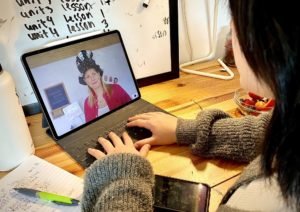
By Mac Hightower, Stuttgart Citizen volunteer
For nine years, Mary Gruver has taught math at Stuttgart High School, her classroom a cornerstone within school walls, where students bring spontaneity, energy, excitement and joy.
That changed on March 20, when the Department of Defense Education Activity gave official notice that school would close due to COVID-19 restrictions. Teachers and students alike had to step away from their classrooms and into the flat-screened world of virtual education.
“A giant hole grew in the hearts of every Panther,” said Principal Rick Renninger, referring to the high school closure. “We are finding ways to fill that hole through the incredible efforts of the staff, students and the entire community.”
Gruver had to adjust the way she taught her students. She and her colleagues rolled up their sleeves and went to work. Their task was to adapt lessons and teaching styles for a digital classroom. Gruver now delivers her classes in 30-minute chunks, streamed to students in their own homes.
Always interested in online learning and presenting material in different ways, Gruver embraced its challenges by exploring new math software and finding teacher groups to help with change. With 20 years of teaching, the technical part was not Gruver’s challenge.
“I miss my students,” Gruver said.
In a normal classroom, Gruver might pair students up to share ideas while she speaks with a few teens one-on-one. She aims to get students to communicate their thoughts and answers – a luxury that is more time-consuming during online sessions.
“It’s difficult for me to engage them in meaningful mathematical discourse and support their productive struggle through an online platform,” Gruver said.
To liven things up, Gruver started wearing a different goofy hat during each class period. Favorites include a turkey hat, cow-boy hat, and bunny ears. Junior Aneysia Rhodes,17, enjoys the way Gruver makes math easier to understand, she said.
“Quarantine is making it a little harder to be hands-on, but she is making it work in the best way possible,” Rhodes said.
At the elementary school level, supporting younger learners, notoriously known for higher energy and being less regimented, poses its own challenges. Tiffany Kelly, a third grade teacher, said students enjoy being in class, even if it is online. Class favorites are “share-time” and class “read-alouds.”
“I kept the same fun activities,” Kelly said. “They are happy with some resemblance of normal.”
Lea Scavetta, a Stuttgart Citizen volunteer, contributed to this article.
